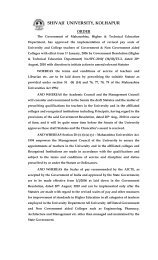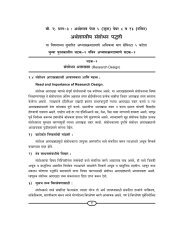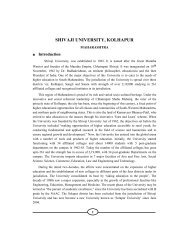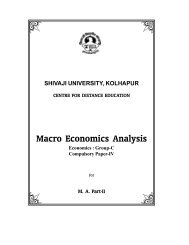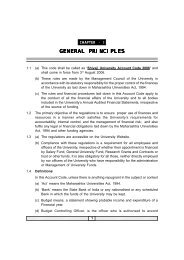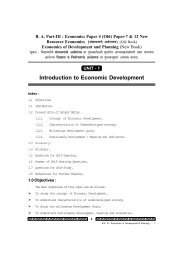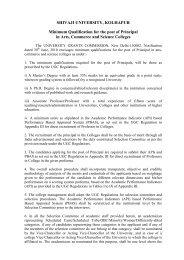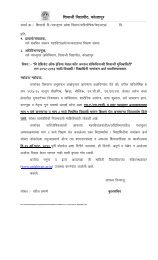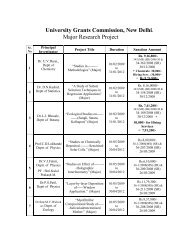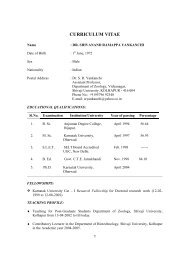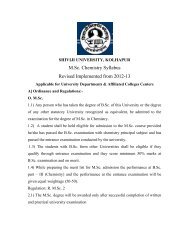B.Ed. (HI) - Shivaji University
B.Ed. (HI) - Shivaji University
B.Ed. (HI) - Shivaji University
Create successful ePaper yourself
Turn your PDF publications into a flip-book with our unique Google optimized e-Paper software.
S<strong>HI</strong>VAJI UNIVERSITY KOLHAPUR<br />
SYLLABUS FOR<br />
BACHELOR OF EDUCATION<br />
IN<br />
SPECIAL EDUCATION<br />
(HEARING IMPAIRMENT)<br />
B.<strong>Ed</strong>. (<strong>HI</strong>)<br />
(Ordinance, Regulations and Curriculum)
CONTENTS<br />
ORDINANCE, REGULATIONS AND STRUCTURE<br />
STANDARD OF PASSING<br />
GENERAL OBJECTIVE OF B.<strong>Ed</strong>. (<strong>HI</strong>) COURSE<br />
WEIGHTAGE ACCORDING TO COURSE<br />
B.<strong>Ed</strong> (<strong>HI</strong>) PART – I : THEORY COURSE<br />
Paper – I <strong>Ed</strong>ucation in Emerging Indian Society.<br />
Paper – II <strong>Ed</strong>ucational Psychology and Persons with Disabilities.<br />
Paper – III <strong>Ed</strong>ucational Planning and Management, Curriculum, Designing and Research<br />
Paper – IV Faciliting Language and Communication Development in Children with Hearing<br />
Impairment.<br />
Paper – V Audiology and Aural Rehabilitation.<br />
Paper – VI Introduction to Speech and Speech Teaching to children with Hearing<br />
Impairment.<br />
Paper – VII Social Science Methodology<br />
Papers – VIII Science and Mathematics Methodology<br />
A. PRACTICE TEAC<strong>HI</strong>NG<br />
B.<strong>Ed</strong> (<strong>HI</strong>) PART – II : PRACTICUM COURSE<br />
i) Classroom Observation<br />
ii) Lesson planning & Exaction<br />
iii) Two Final Lesson<br />
iv) Micro teaching and Simulated Teaching<br />
v) Individualized <strong>Ed</strong>ucational Programme (IEP)<br />
B. PRACTICAL RELATED TO CLINIC<br />
i) Language Skill<br />
ii) Audiology<br />
iii) Speech and Speech Teaching’<br />
iv) Psychology<br />
D. ORGANIZING CO-CURRICULAR<br />
E. EXCURSION.
S<strong>HI</strong>VAJI UNIVERSITY, KOLHAPUR<br />
Degree of Bachelor of <strong>Ed</strong>ucation in Special <strong>Ed</strong>ucation (Hearing Impairment)<br />
(B.<strong>Ed</strong>. (<strong>HI</strong>))<br />
(Ordinance, Regulations and Curriculum for the Degree of Bachelor <strong>Ed</strong>ucation)<br />
O.<strong>Ed</strong>. A candidate for the Degree of Bachelor of <strong>Ed</strong>ucation – Special <strong>Ed</strong>ucation (Hearing<br />
Impairment) must be a Graduate of this <strong>University</strong> or a <strong>University</strong> recognized by this <strong>University</strong><br />
in any faculty (Art / Science / Commerce ). In addition a candidate after Graduation should<br />
have,<br />
I. Kept two terms (the first and the second) of lectures on the theory and practical of<br />
education in a college of education affiliated to this <strong>University</strong> for the purpose of B.<strong>Ed</strong>.<br />
(<strong>HI</strong>)<br />
II. Completed a course of practical work extending over two terms to the satisfaction of the<br />
head of the institution in which candidate is studding consisting of<br />
a) Observation and write the observation report in the prescribed classrooms.<br />
b) Teaching practice of 5 micro-teaching and 5 simulated teaching, 40 lessons<br />
distributed over from pre-primary to secondary classes covering language and<br />
teaching subjects.<br />
c) Practical work in connection with language skills, Audiology, speech and speech<br />
teaching and psychology related to 8 theory papers.<br />
d) Organization and participation in co-curricular activities and excursion.<br />
e) Appearance of practice teaching examination.<br />
R.<strong>Ed</strong>.-01:<br />
The examination for the degree of B.<strong>Ed</strong>. (<strong>HI</strong>) will be conduct only once in the<br />
academic year i.e. in the month of March / April.<br />
A. The examination for the degree of B.<strong>Ed</strong>. (<strong>HI</strong>) will consist of two parts.<br />
Part – I Theory Course (600 marks)<br />
Part – II Practicum Course (600 marks)<br />
B. The B.<strong>Ed</strong>. (<strong>HI</strong>) examination will be of 1200 marks.<br />
Part- I : Theory Course : written examination consisting of eight papers each of three hours<br />
duration carrying 75 marks each (600 marks).<br />
Part-II: Practicum Course : Practicum Course consisting of
(*) College Work :<br />
A. Practice Teaching (400)<br />
1) Classroom Observation (20)<br />
2) Lesson Planning and Execution (200)<br />
3) Two Final Lesson (100)<br />
4) Microteaching and Simulated Teaching (30)<br />
4) Individualized <strong>Ed</strong>ucational Programme (IEP) (50)<br />
C. Clinical Practicum (150)<br />
1) Language Skills (40)<br />
2) Audiology (40)<br />
3) Speech & Speech Teaching (40)<br />
4) Psychology (30)<br />
D. Organizing Co-curricular Activities (30)<br />
E. Excursion (20)<br />
R.<strong>Ed</strong>. 02 :<br />
The following shall be the theory course of study for B.<strong>Ed</strong>. (<strong>HI</strong>) Examination.<br />
Paper – I <strong>Ed</strong>ucation in Emerging, Indian Society<br />
Paper – II <strong>Ed</strong>ucational Psychology and Persons with Disabilities.<br />
Paper – III <strong>Ed</strong>ucational Planning and Management, Curriculum, Designing and Research<br />
Paper – IV Faciliting Language and Communication Development in Children with Hearing<br />
Impairment.<br />
Paper – V Audiology and Aural Rehabilitation.<br />
Paper – VI Introduction to Speech and Speech Teaching to children with Hearing<br />
Impairment.<br />
Paper – VII Social Science Methodology<br />
Paper – VIII Science and Mathematic Methodology
R.<strong>Ed</strong>. 03:<br />
A candidate for the examination in Part-I, in Part-II or in both must apply to the<br />
register by January 15 th of the year with Certificate required by O.<strong>Ed</strong>. – I through the head of<br />
institution in which he has received training.<br />
R.<strong>Ed</strong>. 04:<br />
Standard of Passing<br />
The marks of the B.<strong>Ed</strong>. (<strong>HI</strong>) Part – II Practicum Course be converted in to grades.<br />
O.<strong>Ed</strong>. – 2<br />
To pass the B.<strong>Ed</strong>. (<strong>HI</strong>) Examination, a candidate must obtain;<br />
I) At least 40% marks in each theory paper and 50% marks in the aggregate of all<br />
the theory papers.<br />
II) At least 50 marks in each practicum head the heads shall be as follows.<br />
Head – A Practice Teaching<br />
1) Classroom Observation 20<br />
2) Lesson Planning and Execution 200<br />
3) Two Final Lesson 100 400<br />
4) Microteaching and Simulated Teaching 30<br />
4) Individualized <strong>Ed</strong>ucational Programme (IEP) 50<br />
Head – B Clinical Practicum<br />
1) Language Skills 40<br />
2) Audiology 40<br />
3) Speech & Speech Teaching 40 150<br />
4) Psychology 30<br />
Head – C Organizing Co-curricular Activities 30<br />
Head – D Excursion 20<br />
At least B grade in practicum taken together –<br />
Total : 600<br />
Such a candidate shall be declared to have passed B.<strong>Ed</strong>. (<strong>HI</strong>) Examination in second class. Such<br />
a successful candidate who obtain:<br />
At least 60% marks in the aggregated of all the theory papers taken together and at least ‘A’<br />
grade in the Part – II shall be declared to have passed the B.<strong>Ed</strong>. (<strong>HI</strong>) Examination in first class.<br />
A) At least 70 % marks in the aggregate of the theory papers and at least A + Grade in the Part-<br />
II shall be declared to have passed the B.<strong>Ed</strong>. (<strong>HI</strong>) Examination in first class with<br />
distinction.
B) A candidate who has passed in either B.<strong>Ed</strong>. (<strong>HI</strong>) Part-I or Part-II and declared failed, may<br />
be exempted at his option, from appearing therein at a subsequent attempt, but a candidate<br />
availing himself of such exemption shall not be eligible for first class, first class with<br />
distinction and merit list.<br />
Grade assigned to Part-II shall be carried over to the subsequent examination for<br />
which the candidate is appearing. A candidate whose grade in Part-II is carried over shall<br />
be eligible only for second class.<br />
C) A candidate who has obtained minimum 50% or more marks in any theory paper of<br />
B.<strong>Ed</strong>.(<strong>HI</strong>) Part-I examination shall be eligible to claim exemption in that paper. A<br />
candidate claiming exemption will not be eligible for first class, first class with distinction<br />
and merit list.<br />
General Objectives of B.<strong>Ed</strong>. (<strong>HI</strong>) Course (Teacher <strong>Ed</strong>ucation Programme)<br />
The objective of B.<strong>Ed</strong>. (<strong>HI</strong>) Course (Teacher <strong>Ed</strong>ucation Programmer) are given below.<br />
1) To build knowledge, develop skills and bring about desirable change in the student<br />
trainees so as to equip her/him to become an efficient classroom teacher who can<br />
function in any kind of integrated and segregated set up having students with hearing<br />
impairment.<br />
2) To prepare the student teacher to teach from pre-primary to secondary level, the areas<br />
of expertise includes……<br />
i) Language and subject teaching to the children with hearing impairment.<br />
ii) Ensuing parent professional partnership.<br />
iii) Legal, Social and Professional issues involved with hearing impairment.<br />
3) To develop skills and competencies to cater to the needs of children in general and<br />
children with hearing impairment needs in particular in cognitive, affective and skill<br />
domains in various settings.<br />
4) To acquire knowledge about change in the prevailing and emerging Indian Society in<br />
view of recent trends in education and national development.<br />
5) To perceive the special needs of children and develop confidence in them to realize<br />
their potentials and abilities to meet the national development with self respect,<br />
dignity and freedom.
Course<br />
Paper<br />
and<br />
Section<br />
WEIGHTAGE ACCORDING TO COURSES<br />
Working days: 210 Total working Hours: 1260<br />
Daily working hours: 6 Theory: 600, Practicum: 660<br />
Title<br />
Name of Paper<br />
PART-I :THEORY COURSE.<br />
I <strong>Ed</strong>ucation in<br />
Emerging, Indian<br />
Society<br />
II <strong>Ed</strong>ucational<br />
Psychology and<br />
Persons with<br />
Disabilities.<br />
III <strong>Ed</strong>ucational Planning<br />
Management,<br />
Curriculum,<br />
Designing and<br />
Research<br />
IV Faciliting Language<br />
and Communication<br />
Development in<br />
Children with<br />
Hearing Impairment.<br />
V Audiology and Aural<br />
Rehabilitation.<br />
VI Introduction to<br />
Speech and Speech<br />
Teaching to children<br />
with Hearing<br />
Impairment.<br />
VII Social Science<br />
Methodology<br />
Internal<br />
Marks<br />
External<br />
Marks<br />
15 60 75<br />
Marks Hours Weightage<br />
in terms<br />
of time in<br />
hours %<br />
75<br />
5.92<br />
15 60 75 75 5.92<br />
15 60 75<br />
75<br />
5.92<br />
15 60 75 75 5.92<br />
15 60 75 75 5.92<br />
15 60 75<br />
75 5.92<br />
15 60 75 75 5.92<br />
VIII Science and<br />
Mathematics<br />
Methodology<br />
15 60 75 75 5.92<br />
Total Part - I 120 480 600 600 47.36
Sr.<br />
No.<br />
Title<br />
I Practice Teaching<br />
PART - II - PRACTICUM COURSE<br />
Internal<br />
Mark<br />
Final<br />
Exam.<br />
Total<br />
Marks<br />
1 Classroom<br />
Observation<br />
20 -- 20<br />
2 Lesson Planning &<br />
Execution<br />
(40 Lesson)<br />
200 -- 200<br />
3 Two Final Lesson 100 100<br />
4 Microteaching and<br />
Simulated<br />
Teaching<br />
Hours Weightage<br />
in terms of<br />
time in<br />
hours %<br />
330 Hrs<br />
for 1, 2<br />
& 3 taken<br />
for<br />
together<br />
27.63<br />
30 -- 30 30 2.37<br />
5 Individualized<br />
<strong>Ed</strong>ucational<br />
Programme<br />
(IEP)<br />
50 -- 50 50 3.95<br />
II Clinical Practicum<br />
1 Language Skills 40 -- 40 50 3.95<br />
2 Audiology 40 -- 40 50 3.95<br />
3 Speech & Speech<br />
Teaching<br />
40 -- 40 50 3.95<br />
4 Psychology 30 -- 30 40 3.16<br />
IV Organizing Co-<br />
Curricular<br />
Activities<br />
30 -- 30 30 2.37<br />
V Excursion 20 -- 20 30 2.37<br />
Total Part II 500 100 600 660 53.70<br />
Grant Total<br />
Part I - II<br />
620 580 1200 1260 100
CORE PAPERS
Objective:<br />
PAPER I<br />
<strong>Ed</strong>ucation in Emerging Indian Society<br />
After studying this paper the student teaching are expected to realize the following<br />
1. Explain the History, Nature, Process and Philosophy of education.<br />
2. Spell out the aims and functions of education in general and special education in<br />
particular.<br />
3. Describe the various roles of educational agencies in India.<br />
Unit 1 Introduction to <strong>Ed</strong>ucation<br />
1.1 Meaning and Nature of <strong>Ed</strong>ucation<br />
1.2 Philosophy of <strong>Ed</strong>ucation<br />
1.3 Goals of <strong>Ed</strong>ucation<br />
1.4 Functions of <strong>Ed</strong>ucation<br />
Unit 2 Introduction to Special <strong>Ed</strong>ucation<br />
2.1 Meaning and Nature of <strong>Ed</strong>ucation<br />
2.2 Philosophy of Special <strong>Ed</strong>ucation<br />
2.3 Goals of Special <strong>Ed</strong>ucation<br />
2.4 Functions of Special <strong>Ed</strong>ucation<br />
Unit 3 Historical Perspective of <strong>Ed</strong>ucation<br />
3.1 <strong>Ed</strong>ucation in Ancient, Medieval and Pre-Independent India<br />
3.2 <strong>Ed</strong>ucation in Post-Independent India<br />
3.3 History of Special <strong>Ed</strong>ucation (With special emphasis on selected disability an<br />
Indian perspective)<br />
Unit 4 <strong>Ed</strong>ucation in the social context<br />
4.1 Agencies of <strong>Ed</strong>ucation (Formal, Informal, Non-Formal)<br />
4.2 Role of Home, School Society, Mass Media, GO’s and NGO’s such as NCERT,<br />
SCERT, NCTE, RCI, National Institute for Handicapped, UNICEF, UNESCO,<br />
WHO, Action Aid and CBM<br />
4.3 Functional Literacy and Continual <strong>Ed</strong>ucation<br />
4.4 Value Oriented <strong>Ed</strong>ucation<br />
4.5 Community Based Rehabilitation (CBR)
Unit 5 Legislation<br />
5.1 Recommendation of various Committees and Commission (Kothari Commission,<br />
Radhakrishanan Commission, Mudhaliar Commission)<br />
5.2 National Policy of <strong>Ed</strong>ucation – 1986<br />
5.3 RCI Act – 1992<br />
5.4 PWD Act – 1995<br />
5.5 National Trust Act – 1999<br />
5.6 IEDC Scheme<br />
5.7 Biwako Millennium Framework and its Implication<br />
Unit 6 <strong>Ed</strong>ucational Mainstreaming<br />
6.1 Intergraded <strong>Ed</strong>ucation<br />
6.1.1 Meaning, Definition and Need<br />
6.1.2 Advantage and Disadvantage<br />
6.1.3 Types of Integration<br />
6.1.4 Factors Contributing to successful integration (Child, Family, Special, Regular<br />
School And Govt. Policies)<br />
6.1.5 Resources unit and Resource Teacher (Importance and Role)<br />
6.2 Inclusive <strong>Ed</strong>ucation<br />
Unit 7 Modern Trends in <strong>Ed</strong>ucation<br />
7.1 Barrier Free <strong>Ed</strong>ucation<br />
7.2 Community Awareness Programme<br />
7.3 Planning and Management of Human Resource<br />
7.4 Role of Teacher in Emerging Indian Society<br />
References:<br />
1. Anand. (1993). The Teacher & <strong>Ed</strong>ucation in Emerging Indian Society. NewDelhi<br />
NCERT.<br />
2. Saraswathi. T.S. (1999). Culture, Socialization and Human Development.<br />
Sage Publications.<br />
3. Steven. B. (1998). School and Society. Sage Publications.<br />
4. Suresh. D. (1998). Curriculum and child development. Bhargava.<br />
5. Taneja. V.R. (1998). <strong>Ed</strong>ucational Thoughts and Practice. Delhi <strong>University</strong> Publications.
6. Weber. O.C. (1990). Basic Philosophies of <strong>Ed</strong>ucation. New York Holt, Rinehart and<br />
Winston.<br />
7. Aggarwal. J.C. (1992). Development and planning of Modern <strong>Ed</strong>ucation. New Delhi<br />
Vikas Publishing House Pvt. Ltd.<br />
8. Biswas. A. and Aggarwal, J.C. (1992). <strong>Ed</strong>ucation in India. New Delhi Arya Book Depot.<br />
9. Bhat. B.D. (1996). <strong>Ed</strong>ucational Documents in India. New Delhi Arya Book Depot.<br />
10. Bhatia, Kamala and Bhatia, Balder. (1997). The Philosophical and Sociological<br />
Foundations. New Delhi Doaba House.<br />
11. Biswas. A. (1992). <strong>Ed</strong>ucation in India. New Delhi Arya Book Depot.<br />
12. Mohanty, Jagannath. (1993). Indian <strong>Ed</strong>ucation in the Emerging Society. New Delhi<br />
Sterling publishers Pvt. Ltd.<br />
13. Sapra. C.L. and Ash Aggarwal, (<strong>Ed</strong>.,) (1987). <strong>Ed</strong>ucation in India Some critical Issues.<br />
New Delhi National Book Organisation.<br />
14. Choudhary. K.C. and Sachdeva, L. (<strong>Ed</strong>s) (1995). Total literary by 2000.. New Delhi IAE<br />
Association.
Objective:<br />
PAPER II<br />
<strong>Ed</strong>ucation Psychology and Persons with Disabilities<br />
After studying this paper the student teaching are expected to realize the following<br />
1. Discuss the concepts and principles of growth and development<br />
2. describe the various theories of learning and their implication to the disabled<br />
3. Explain the concepts of intelligence and aptitude in general and with specific reference to<br />
the disabled<br />
4. spell out the meaning and concept of personality and mental health and their implication<br />
to the disabled<br />
5. Define the meaning and techniques of guidance and counseling I general and special<br />
reference to the disabled.<br />
6. Explain the effects of hearing impairment in child development<br />
Unit 1 Introduction to <strong>Ed</strong>ucational Psychology<br />
1.1 Definition, Nature and Scope of Psychology<br />
1.2 <strong>Ed</strong>ucational Psychology: Scope and Relevance to General <strong>Ed</strong>ucation<br />
1.3 Role of <strong>Ed</strong>ucational Psychology in Special <strong>Ed</strong>ucation<br />
1.4 Theories and Application in <strong>Ed</strong>ucational Motivation, Attention and Perception<br />
1.5 Implications of the above with regard to specific disabilities<br />
Unit 2 Growth and Development<br />
2.1 Concepts of Growth and Development<br />
2.2 Concept of growth and development<br />
2.3 Principles of Development<br />
2.4 Developmental needs of Preschool stage, Childhood and Pre-adolescence<br />
2.5 Influence of Heredity and Environment<br />
2.6 Individual difference, Development Deviances and related issues with regards to<br />
Unit 3 Learning<br />
specific disability (<strong>HI</strong>)<br />
3.1 Definition, Meaning and Concepts Formation<br />
3.2 Learning Domains and factors affecting learning
3.3 Theories and application in educational Motivation, Attention and Perception<br />
3.4 Remembering, Forgetting and Transfer of learning<br />
3.5 Implications of the above with regard o various disability<br />
Unit 4 Intelligence and Aptitude<br />
4.1 Definition and Meaning of Intelligence and Aptitude<br />
4.2 Theories of Intelligence and Intelligence Tests<br />
4.3 Concept of Aptitude and Aptitude Tests<br />
4.4 Individual differences and their implications in education<br />
4.5 Implication of the above with regard to various disabilities<br />
Unit 5 Personality<br />
5.1 Definition, Meaning and Dimensions of personality<br />
5.2 Theories of Personality<br />
5.3 Frustration and Conflict, Adjustment Mechanisms and Behavior Deviation<br />
5.4 Mental health and stable personality<br />
5.5 Implications of the above with regard to the specific disability<br />
Unit 6 Intervention<br />
6.1 Guidance and Counseling<br />
6.2 Nature, Meaning and Scope<br />
6.3 Parent Guidance and Stress Management<br />
6.4 Discipline and Behavioral Techniques<br />
6.5 Play Therapy<br />
6.6 Psycho <strong>Ed</strong>ucational Remedial Work<br />
Unit 7 Psychological Assessment<br />
7.1 Meaning, Definition and Aims of Assessment<br />
7.2 Principles of Assessment<br />
7.3 Area of Assessment<br />
7.4 Tests and Tools<br />
7.5 Role of Psychological Assessment in <strong>Ed</strong>ucation<br />
References:<br />
1. Adams J.A. (1992). Learning and memory An introduction. Homewood, Illinois Dorsey<br />
Press.
2. Brody. E.B. and Brody. N. (1996). Intelligence Nature, determinants and consequences.<br />
New York : Academic Press,<br />
3. Butcher. H.]. (1993). Human Intelligence: Its nature and assessment. London Merhuen.<br />
4. Gottfried. A.VV. (1995). Home Environment and Early cognitive Development. San<br />
Francisco.<br />
5. Guilford. ].B. (1996). Fields of Psychology (ed.,) New York: Van Nostrand.<br />
6. Hunter, Ian. M.R. (1994). Memory, London : Penguin Books.<br />
7. Keller. F.S. (1997). The Definitions of Psychology (<strong>Ed</strong>.,). New York: Appleton century.<br />
8. Munn. N.L. (1997). Introduction to Psychology. Delhi.<br />
9. Petri. H.L. (1995). Motivation: Theory and Research, 2nd ed., Belmont,<br />
Cawadsworth.<br />
10. Sawrey. J.H. and Telford. C. (1998). <strong>Ed</strong>ucational Psychology (2nd ed.,) New Delhi<br />
Prentice Hall of India.<br />
11. Simth, Mdaniel. (1998). <strong>Ed</strong>ucational Psychology. New York : Allyn & Bacon.<br />
12. Skinner. B.F. (1997). verbal Behaviour. New York : Appleton century Crofts.<br />
13. Travers. R.M. (1993). <strong>Ed</strong>ucational Psychology. New York: Macmillan,<br />
14. Watson. LB. (1993). Psychology as a behaviourist views t Psycho. Rev., Vol. 20.<br />
15. Woodworth. R.S. (1994). Experimental Psychology, New York: Hot<br />
16. Barciey. J.R. (1993). Counselling and Philosophy. San Francisco.<br />
17. Floelick. C.P. (1988). Guidance Services in Schools. New York : Allynn & Bacon.<br />
18. Jones. A.P. (1994). Principles of Guidance. New York: Holt.<br />
19. Traxier. A. .1. (1990). Techniques of Guidance New Delhi Prentice Hall of India.
PAPER III<br />
<strong>Ed</strong>ucational Planning and Management, Curriculum Designing and Research<br />
Objective:<br />
objectives<br />
After this paper the student teachers are expected to realize the following<br />
1. Explain the Nature of <strong>Ed</strong>ucational Needs and Classification of Disability<br />
2. Discuss the meaning, need and scope of educational management<br />
3. Define the concept and meaning of curriculum and instructional strategies<br />
4. explain the concept, meaning, scope, and type of educational technology<br />
5. Describe the need and scope of educational research<br />
6. discuss the meaning, scope and type of educational evaluation<br />
Unit 1 Introduction of Various Disabilities<br />
1.1 Concepts and Definitions of Impairment, Disability and Handicap<br />
1.2 Identification, Characteristics and Classification of Disabilities<br />
1.2.1 Blindness and Low Vision<br />
1.2.2 Hearing Impairment<br />
1.2.3 Mental Retardation<br />
1.2.4 Leprosy Cured, Neurological and Locomotor Disabilities<br />
1.2.5 Learning Disabilities<br />
1.2.6 Autism and other Associated Disorders<br />
1.2.7 Various Combination of Disability<br />
1.3 Prevalence of Disabilities<br />
1.4 Effects of disability on <strong>Ed</strong>ucational Achievements<br />
1.5 <strong>Ed</strong>ucational Needs<br />
1.6 <strong>Ed</strong>ucational Management<br />
Unit 2 <strong>Ed</strong>ucational Management<br />
2.1 Definition, Meaning, Need, Scope of <strong>Ed</strong>ucational Management<br />
2.2 Concept and Principle of Institutional planning and Management, Admission,<br />
School plant Classification Provision<br />
2.3 Organization and Management of different <strong>Ed</strong>ucational Programme of <strong>HI</strong> – PIP,<br />
Pre-School, Pre-Primary, Primary, Secondary and Pre- Vocational
2.4 Role and Duties of Head Master and Teacher<br />
2.5 Time-Table<br />
2.6 Inspection and Supervision<br />
2.7 Evaluation of <strong>Ed</strong>ucational Programme<br />
Unit 3 Curriculum<br />
3.1 Meaning, Definition and Principles of Curriculum.<br />
3.2 Principles of Curriculum Construction<br />
3.3 Curriculum Planner, Implementation and Evaluation<br />
3.4 Study of Existing Curriculum at -<br />
- Preprimary,<br />
- Primary,<br />
- Secondary Level<br />
3.5 Role of Text Books<br />
3.6 Curriculum Adaptations – Need and Process (at all level)<br />
3.7 Co- curricular Activities – Meaning Importance and Types<br />
Unit 4 Instructional Strategies<br />
4.1 Lesson planning<br />
4.1.2 Task analysis of content<br />
4.1.3 Formulating instructional objectives<br />
4.1.4 Evaluation of instructions<br />
4.2 Grouping for instructions<br />
4.3 Individualized <strong>Ed</strong>ucation Programme (IEP)<br />
4.4 Micro- teaching<br />
Unit – 5 <strong>Ed</strong>ucational Technology<br />
5.1 Concept and Scope<br />
5.2 Role and types of Audio, Printed, Audio Visuals<br />
5.3 Programmed Learning Computer Assistive Learning and Interactive Learning<br />
5.4 Teaching Learning Material (Teaching Aids)<br />
5.5 Environmental modifications and use of assistive technology for persons with<br />
disabilities.<br />
Unit – 6 <strong>Ed</strong>ucational Research<br />
6.1 Definition Need and Scope of education research<br />
6.2 Principles of research in education
6.3 Process of education research<br />
6.4 Types of research design<br />
6.5 Sources of research problems in special education<br />
6.6 Description statistics, measures of central tendencies (mean, medium, mode)<br />
variance (Standard deviation ,quartile deviation)<br />
6.7 Inferential statistics, correlation rank correlation, construction of different graphs<br />
and diagrams.<br />
Unit – 7 <strong>Ed</strong>ucational Evaluation<br />
7.1 Definition, meaning , scope and types of educational evaluation<br />
7.2 Various types of tests.<br />
7.3 Characteristics of a good test<br />
7.4 Construction of test items criterion reference test (CRT) norm reference test<br />
References:<br />
(NRT), teacher made tests (TMT)<br />
1. Poremba, C. The adolescent and young adult with learning disabilities what are his<br />
needs? What are the needs of those abilities of children and youth. Tuisa The Association<br />
for Children with Learning Disabilities, 1967 pp. 142-148.<br />
2. Byrne, M., Shervanian, C., Introduction to Communicative Disorders. New York Harper<br />
& Row, 1977.<br />
3. Mani, M.N.G., Techniques of teaching blind children, New Delhi Sterling Publishers,<br />
1992.<br />
4. Jangira, N.K., & Mani, M.N.G., Integrated <strong>Ed</strong>ucation of the visually Handicapped,<br />
Management Perspectives. Gurgaon Academic Press, 1991.<br />
5. Harely, R.K., and Lawrence, G.A., Visual Impairment in the Schools. Springfield, IL<br />
Charles C. Thomas, 1977.<br />
6. Davis, (<strong>Ed</strong>.) Our forgotten children Hard-of hearing pupils in the schools. Minneapolis<br />
National Support Systems Project 1977.<br />
7. Overton, T. (1992). Assessment in Special <strong>Ed</strong>ucation An Applied Approach. New York<br />
McMillan.<br />
8. Panda, K.C. (1997). <strong>Ed</strong>ucation of Exceptional Children. New Delhi Vikas Publications.<br />
9. Subba Rao, T.A. (1992). Manual on Developing Communication Skills in Mentally<br />
Retarded Persons, NIMH, Secunderabad.
10. Van Riper, C.A. and Emerick. L. (1990), Speech Correction-An introduction to speech<br />
pathology and Audiology. Eighth <strong>Ed</strong>ition, Prentice Hall.<br />
11. Taylor, R.L. (1993). Assessment of Exceptional Students <strong>Ed</strong>ucational and Psychological<br />
Procedures. Boston Allyn Bacon.<br />
12. Baine, D. (1988) Handicapped Children in Developing Countries, Assessment,<br />
curriculum and Instruction. <strong>University</strong> of Alberta, Alberta.<br />
13. Longone, 3. (1990). Teaching Retarded learners Curriculum and Methods for improving<br />
instruction. Allyn and bacon Boston.<br />
14. Narayan, & Kutty, A.T.T. (1989) Handbook for Trainers of the Mentally Retarded<br />
persons. Pre-primary level. NIMH, Secunderabad.<br />
15. Peshwaria, R. and Venkatesan (1992) Behavioural retarded children A manual for<br />
Teachers. NIMH, Secunderabad.<br />
16. Evans, P and Verma, V. (<strong>Ed</strong>s.) (1990) Special <strong>Ed</strong>ucation. Past Present and Future. The<br />
Faimer Press.<br />
17. Muricken, Jose S.J. and Kareparampil, G (1995). Persons with Disabilities in Society.<br />
Trivandrum Kerala Federation of the Blind.<br />
18. Myreddi, V. & Narayan, J. <strong>Ed</strong>ucating Children, Secunderabad, NIMH<br />
19. Narayan, J. <strong>Ed</strong>ucating Children with Learning Problems in Regular Schools,<br />
Secunderabad, NIMH.<br />
20. Cima M Yeole. (1991). <strong>Ed</strong>ucational Technology. Cima Myeole.<br />
21. Dipika Bhadresh Shah, (1991). <strong>Ed</strong>ucational Technology for developing teaching<br />
competence Gavendra Prakashan.<br />
22. Jaganath Mohanty. (1998). Studies in <strong>Ed</strong>ucational Broadcasting. San subscription<br />
agency.<br />
23. Mangal K. (1990). Fundamentals of <strong>Ed</strong>ucational technology. Prakash Brothers<br />
24. Ruhela Satyapal. (1991). <strong>Ed</strong>ucational Technology, A systematic Text Book Associated<br />
Publishers.<br />
25. Sita Ram Sharma & A.L. Vohra. (1993). Encyclopaedia of <strong>Ed</strong>ucational Technology.<br />
Anmol Publications.<br />
26. Tara Chand. (1992). <strong>Ed</strong>ucational Technology. Anmol Publication.
27. Aggarwal. Y.P. (1992) Research in Emerging Fields of <strong>Ed</strong>ucation concepts, trends and<br />
prospects. New Delhi Sterling Publishers.<br />
28. Aggarwal. Y.P. (1994). Better sampling. New Delhi Sterling Publishers.<br />
29. Anand. S.P. (1996). RCEB Tools for secondary class students. Bhubaneswar Shovan.<br />
30. Belok, Michael. V. (1993). Naturalistic Research Paradigms. Meerut: Anu Books.<br />
31. Buch. M.B. (1991). Fourth Survey of Research in <strong>Ed</strong>ucation. Vol I and II, New Delhi<br />
NCERT.<br />
32. Martyn, Hammersley. (1996). case Studies in classroom research. Philadelphia Open<br />
<strong>University</strong> Press.<br />
33. Shukla. S.P. (1996). Elements of <strong>Ed</strong>ucational Research. Bombay Allied Publishers (P)<br />
Ltd.<br />
34. Young, Pauline. V. (1992). Scientific Social Surveys and Research, Bombay Asia<br />
Publishing House,<br />
35. D.ES, (1982). Handicapped Pupil and Special schools, Regulations. London HMSO.<br />
36. Govt. of India, Persons with Disability Act, 1995.<br />
37. Evens, P. and Varma. V (1990). Special <strong>Ed</strong>ucation Past, Present and Future, The Falmer<br />
Press. London. Ch. 4 & 14.<br />
38. Zirpoli, T.J. & Mellor, K.J. (1993) Behaviour Management Application for Teachers and<br />
Parents Toronto Maxwell McMillan, Canada.
SPECILALIZATION PAPERS
PAPER – IV<br />
Facilitating Language & Communication Development In Children With<br />
Objectives :<br />
objectives.<br />
Hearing Impairment.<br />
After studying the paper the student teachers are expected to realize the following<br />
1. To understand meaning, function and development of communication of language and<br />
communication.<br />
2. To study language development hearing effect of hearing impairment on it.<br />
3. To understand the need to develop reading and writing skills to support receptive and<br />
expressive languages.<br />
4. To understand various types of assessment of language.<br />
UNIT 1: Introduction To Communication<br />
1.1 Definition, meaning and scope of communication.<br />
1.2 Classification of communication.<br />
(verbal/manual/graphical, linguistic non linguistic, human/animal)<br />
1.3 Modes of linguistic communication.<br />
UNIT 2: Methods Communication<br />
2.1 Meaning of oralism.<br />
(Philosophy, Justification, advantages, disadvantage of oralism)<br />
2.2 Total communication<br />
(Philosophy, justification, advantage, disadvantage.)<br />
2.3 <strong>Ed</strong>ucational Bilingualism.<br />
2.3 Manualism<br />
(Philosophy, justification, advantage, disadvantage.)<br />
(Cused speech, Rochester method, sign system, sign language, finger spelling.)<br />
2.4 Speech Reading<br />
2.4.1 Meaning and definition<br />
2.4.2 Role in communication and education<br />
2.4.3 Development of speech reading skills<br />
2.4.4 Speech reading of Indian language.
UNIT 3: Language<br />
3.1 Definition, meaning and functions of language.<br />
3.2 Structure, characteristics of language.<br />
3.3 Biological and Psychological foundation of language and concept of critical age.<br />
3.4 Development of language in non-impaired child.<br />
UNIT 4: Languages Of Children With Hearing Impairment<br />
4.1 Language Development of children with hearing impairment.<br />
4.2 Principles of teaching language.<br />
4..3 Methods of teaching language.<br />
* Natural Method.<br />
* Structural Method<br />
* Combined Method<br />
4.4 Special techniques of teaching language.<br />
(News/Conversation, Directed Activity, Visit, Free play, story Telling,<br />
picture comprehension)<br />
4.5 Developing grammar.<br />
UNIT 5: Reading and Writing<br />
5.1 Development of Motor co-ordination visual perception and Auditory perception.<br />
5.2 Reading readiness (pre reading skills and sight vocabulary)<br />
5.3 Development of Reading<br />
a) Goals and Importance of Reading.<br />
b) Classification of Reading<br />
b-1) According to goal (Functional, Recreational, Remedial and<br />
development)<br />
b-2) According to method (Loud Reading, silent reading)<br />
5.4 Development of Writing.<br />
a) Pre writing skill development.<br />
b) Goals and Importance of writing.<br />
c) Development of writing (look and write, listen and write, write, writing with<br />
proper speed and comprehensive (legible) and spontaneous writing).<br />
UNIT 6: Assessment of Language<br />
6.1 Meaning Definition and scope in education.<br />
6.1 Types of assessment (Formal, Informal their selection).<br />
6.1 Standardized language testing : meaning scope and Indian tests.<br />
6.1 Classroom assessment techniques
– Knowledge based/language based<br />
– Open ended / close ended<br />
– Direct / Indirect/ Inferential<br />
UNIT 7: Role of Functionaries<br />
7.1 Role of parents and other family members.<br />
7.1 Parent teacher partnership.<br />
7.1 Parent guidance.<br />
7.1 Sociological Implications – attitudes of siblings, peers, parents, teachers,<br />
community.<br />
7.1 Teacher’s role in community awareness.<br />
Reference:<br />
1. Bender, R., The conquest of deafness. Cleveland, OH Western Reserve <strong>University</strong>, 1985.<br />
2. Davis, 3, (<strong>Ed</strong>.) Our forgotten children Hard-of hearing pupils in the schools. Minneapolis<br />
National Support Systems Project 1g77.<br />
3. Davis, H., Silverman, S.R., Hearing and deafness. New York Holt, Rinehart & Winston,<br />
1970.<br />
4. Frisna, R., (<strong>Ed</strong>.) A bicentennial monograph on hearing impairment - Trends in the USA.<br />
The Volta Review, 1976 (4).<br />
5. Hart, B.O. Teaching reading to the deaf, Washington, DC The Alexander Graham Bell<br />
Association for the Deaf. Inc., 1963.<br />
6. Ling, D., Speech and the hearing-impaired child Theory and Practice. Washington, DC<br />
The Alexander Graham Bell Association for the Deaf. Inc., 1976.<br />
7. Streng, A., Syntax, Speech and hearing. New York Grunne and Stration, 1972.<br />
8. Furth, H.G., Thinking without language. New York Free Press 1966.<br />
9. Jeffers, J., & Barley, M., Speech Reading (Lip reading). Spring field, IL Charles C.<br />
Thomas, 1975.<br />
10. O’rourke, T., A basic course in manual communication, Siller Spring MD National<br />
Association of the Deaf, 1970.<br />
11. Sanders, D.A., Aural rehabilitation. Englewood Cliffs, NJ: Prentice Hall, 1971.
Objectives :<br />
objectives.<br />
PAPER – V<br />
AIDIOLOGY AND AURAL REHABILITATION<br />
After studying the paper the student teachers are expected to realize the following<br />
1. Describing the Anatomy and Physiology of the ear. Assessing the hearing capability of<br />
an Individual.<br />
2, Operating an Audiometer and assessing the hearing loss in adults, infants and children.<br />
3. Understanding the functions of hearing aids and use of hearing aid.<br />
4. Counseling the parents regarding the role of hearing aids rehabilitation of the hearing<br />
impaired child<br />
UNIT 1: Hearing Mechanism<br />
1.1 Basic Anatomy and Physiology<br />
1.1.1 Basic Anatomy and Physiology of hearing mechanism – outer, middle and inner<br />
ear<br />
1.1.2 Central hearing mechanism<br />
1.2 Nature & classification of hearing impairment<br />
1.2.1 Degree of hearing impairment<br />
1.2.2 Type of heating impairment<br />
1.2.3 Time of onset (Age of onset)<br />
1.3 Causes and prevention of hearing loss (Types of services available for prevention<br />
of hearing loss in India) – Role of GO’s and NGO’s – 3 levels of prevention,<br />
professionals involved in prevention, importance of prevention<br />
UNIT 2: Early Identification and Imoportance Test<br />
2.1 Early Identification of hearing loss<br />
2.1.2 Need and importance of early identification<br />
2.2 Importance Test<br />
2.2.1 Subjective and Objective methods of identification concept of ‘subjective’ and<br />
‘objective’ tests<br />
List of subjective tests<br />
List of objective tests<br />
BOA- Pediatric hearing assessment
Concept of conditioning (Visual, Auditory)<br />
Conditioning audiometry<br />
2.2.2 School screening<br />
UNIT 3: Introducation to Physics of Sound<br />
3.1 Concept, definition of ‘Sound’<br />
3.2 Production and propagation of sound<br />
3.3 Attributes of sound – Frequency, Intensity, Quality and their psychological<br />
Correlates<br />
3.4 Concept of dB – (pressure and power) – Brief orientation<br />
UNIT 4: Audiometery<br />
4.1 Sound propagation of sound and parameters of sound zero dB reference for<br />
pressure and power<br />
4.2 Purtone Audiometry and speech Audiometry use of masking parts and use of<br />
audiomerts. Free field audiometry, aided and unaided audiogram<br />
4.3 Interpretation of Audiogram, concept of speech banana basic and educational<br />
implications<br />
4.4 Case History and its importance. Skills required for taking a case History<br />
UNIT 5: Hearing Aid<br />
5.1 Hearing Aid<br />
5.1.1 Parts of hearing aid, their function<br />
5.1.2 Types of hearing aid,<br />
5.1.3 Selection of Hearing Aid<br />
5.1.4 Daily assessment of haring aid – 6 sound test<br />
5.1.4 Hearing aid use<br />
5.2 Ear Mould<br />
5.2.1 Types of ear mould<br />
5.2.2 Importance of ear mould<br />
5.3 Care and maintenance of Hearing Aid and Ear Mould<br />
5.3.1 Trouble shooting and minor repairs<br />
5.4 Harness<br />
UNIT 6: Classroom Management<br />
6.1 Setting up of a classroom for children with hearing impairment children and<br />
classroom acoustics, sound, Noise ratio ways to improve it.
6.2 Classroom amplification devices, hard wire, Induction loop, FM system and intra<br />
red speech trainer<br />
UNIT 7: Auditory Training and Aural Rehabilitation<br />
7.1 Definition, meaning and scope of Auditory training and importance for<br />
comprehension of spoken language and approaches<br />
7.2 Stages of Auditory training<br />
7.3 Use of gross sounds, environment sounds and voice<br />
7.4 Discrimination between speech sound loudness, stress and temporal factors like<br />
rhythm and pauses<br />
7.5 Aural Rehabilitation<br />
7.5.1 Role of Parents<br />
7.5.2 Assistive listening devices<br />
7.5.3 Cochlear Implant<br />
References:<br />
1. Brown, R. A first language the early stages. Cambridge, M.A. Harvard <strong>University</strong> Press.<br />
1978.<br />
2. Dale, P. Language development, New York Holt Rinehart & Winston 1976.<br />
3. Templin, M., Certain language skills in children. Minneapolis <strong>University</strong> of Minnesota<br />
Press,1957.<br />
4. Trantham, C., & Pederson, Normal language development. Baltimore Williams &<br />
Wilkins Co., 1976.<br />
5. Byrne, M., Shervanian, C., Introduction to Communicative Disorders. New York Harper<br />
& Rwo, 1977.<br />
6. Emerick, L., Hatten, J., Diagnosis and evaluation in speech pathology. Englewood Cliffs,<br />
NJ Prentice-Hall, 1985.<br />
7. Travis, E. (<strong>Ed</strong>) Handbook of speech pathology. Englewood Cliffs NJ Prentice Hall,<br />
1971.<br />
8. Winitx, H. From Syllable to conversation. Baltimore: <strong>University</strong> Park press, 1975.<br />
9. Stark, 3. Reading failure: A language based problem. Asha, 1975 17, 832-834.<br />
10. Jeffers & Barley, N., Speech reading (Lip reading). Spring field, IL Charles C. Thomas,<br />
1975.
11. O’rourke, T., A basic course In manual communication, Siller Spring MD National<br />
Association of the Deaf, 1970.<br />
12. Sanders, D.A., Aural Rehabilitation. Englewood Cliffs, N.J: Prentice-Hall, 1971.
PAPER VI<br />
Introduction to Speech and Speech Teaching to the Children with Hearing<br />
Objective<br />
Impairment<br />
1. To acquaint the student teacher with the Anatomy and Physiology of the Articulatory<br />
system.<br />
2. To acquaint the teacher with the normal development of speech.<br />
3. To acquaint the teacher with the normal development of speech in a Hearing Impairment<br />
child.<br />
4. To acquaint the teacher with the disorders in the speech in a Hearing Impairment<br />
children.<br />
5. To acquaint the student teacher with methods of correcting the disorders in the speech of<br />
the Hearing impaired, individually and in the classroom.<br />
UNIT 1: Speech Mechanism<br />
1.1 Definition and functions of speech<br />
1.2 Anatomy and Physiology of the Respiratory, Phonatory, articulary, Resonatory,<br />
Regulatory system<br />
1.3 Pre-requisites for the production of speech<br />
1.4 Speech as an overlaid function<br />
UNIT 2: Normal Speech Production and Reception<br />
2.1 Characteristics of speech, parameters of speech intelligibility speech<br />
2.2 Non segmental and supra segmental aspects of speech<br />
(Voice, duration pitch, loudness, quality rhythm, rate, intonation, stress, accent<br />
phrasing, pause)<br />
2.3 Multi sensory speech reception, hearing and vision, hearing and toch, vision and<br />
touch, hearing<br />
UNIT 3: Introduction to Phonetics<br />
3.1 Definition, meaning of phonetics<br />
3.2 Description and classification of speech sounds<br />
3.3 Classification of speech sounds (Vowels, Consonants and Diphthongs)<br />
3.4 Introduction to I.P.A. with reference to phonemes of Indian languages
3.5 Relevance of phonetics in the correction of speech of Hearing Impaired children<br />
UNIT 4: Development of Speech<br />
4.1 Development of speech in children with normal hearing (Pre – requisites and<br />
stages)<br />
4.2 Factors affecting development of speech<br />
4.3 Development of speech in children with hearing impairment (Pre lingual and post<br />
lingual)<br />
UNIT 5: Characteristics of Speech Children with Hearing Impairment<br />
5.1 Articulation of errors<br />
5.2 Voice defects<br />
5.3 Errors in supra-segmental<br />
UNIT 6: Speech Perception and Assessment of Speech<br />
6.1 Perception of speech with and without hearing aid<br />
6.2 Description and classification of speech errors presents in the speech of a hearing<br />
impaired child<br />
6.3 Assessment of voice vocalization, duration, loudness, pitch and voice quality<br />
6.4 Assessment of speech sounds (articulation) vowels, consonants, diphthongs<br />
6.5 Equipment and soft wares available for assessment and correction of speech<br />
6.6 Planning for correction of the error detected<br />
UNIT 7: Speech Teaching<br />
7.1 Models of speech teaching (Developmental and correctional)<br />
7.2 Approaches to speech teaching<br />
(Auditory global, multi sensory syllable unit and associated phoneme unit)<br />
7.1 Stages and principles of speech teaching by D. Ling<br />
7.2 Individual speech teaching, classroom speech teaching activities and speech<br />
teaching strategies, teaching aids, equipments and software’s<br />
7.3 Speech teaching strategies and teaching aids for pre-primary and secondary<br />
school level<br />
7.4 Role of parents in development and maintenance of intelligible speech in the<br />
References:<br />
children with hearing impairment<br />
1. Bender, R., The conquest of deafness. Cleveland, OH Western Reserve <strong>University</strong>, 1985.
2. Davis, J., (<strong>Ed</strong>.) Our forgotten children Hard-of hearing pupils in the schools. Minneapolis<br />
National Support Systems Project 1977.<br />
3. Davis, H., Silverman, S.R., Hearing and deafness, New York Holt, Rinehart & Winston,<br />
1970.<br />
4. Frisna, R., (<strong>Ed</strong>.) A bicentennial monograph on hearing impairment Trends in the USA.<br />
The Volta Review, 1976 (4).<br />
5. Hart, B.O. Teaching reading to the deaf, Washington, DC The Alexander Graham Bell<br />
Association for the Deaf. Inc., 1963.<br />
6. Ling, D., Speech and the hearing-impaired child Theory and Practice. Washington, DC<br />
The Alexander Graham Bell Association’ for the Deaf. Inc., 1976.<br />
7. Streng, A., Syntax, Speech and hearing. New York Grunne and Stration, 1972.<br />
8. Furth, H.G., Thinking without language. New York Free Press 1966.<br />
9. Brown, R. A first language the early stages. Cambridge, M.A. Harvard <strong>University</strong> Press.<br />
1978.<br />
10. Dale P. Language development, New York Holt Rinehart & Winston<br />
11. Templin, M., Certain language skills in children. Minneapolis <strong>University</strong> of Minnesota<br />
Press, 1957.<br />
12. Trantham, C., & Pederson, 3, Normal language development. Baltimore Williams &<br />
Wilkins Co., 1976.<br />
13. Byrne, M., Shervanian, C., Introduction to Communicative Disorders. New York Harper<br />
& rwo, 1977.<br />
14. Emerick, L., Hatten, 3, Diagnosis and evaluation in speech pathology. Englewood Cliffs,<br />
NJ prentice-Hall, 1985.<br />
15. Travis, E. (<strong>Ed</strong>) handbook of speech pathology. Englewood Cliffs NJ Prentice Hall, 1971.<br />
16. Winib, H. From Syllable to conversation. Baltimore <strong>University</strong> park press, 1975.<br />
17. Stark, 3. Reading failure A language based problem. Asha, 1975 17, 832-834.<br />
18. Jeffers, 3. & Barley, M., Speech reading (Lip reading). Spring field, IL Charles C.<br />
Thomas, 1975.<br />
19. O’rourke, T., A basic course in manual communication, Siller Spring MD National<br />
Association of the Deaf, 1970.<br />
20. Sanders, D.A., Aural rehabilitation. Englewood Cliffs, NJ Prentice-Hall, 1971.
METHODOLOGY PAPERS
Objective:<br />
objectives.<br />
PAPERS VII<br />
Social Science Methodology<br />
After studying the paper the student teachers are expected to realize the following<br />
1. Understand place and importance of school curricular and human life.<br />
2. Understand methods, techniques and devices of teaching history.<br />
3. Use verity of learning’s experience of instructional materials white teaching subject.<br />
4. Co-curricular and curricular activities related to school subject.<br />
UNIT 1: Place in the Curriculum and Life<br />
1.1 Importance<br />
1.2 Objective and specifications of teaching at Primary, Secondary and Higher<br />
Secondary Levels of education<br />
1.3 Correlation with other school subjects, internal, external<br />
UNIT 2: Maxims and Methods of Teaching<br />
2.1 Maxims of Teaching: Known to Unknown, Simple to Complex, Concrete to<br />
Abstract<br />
2.1 Methods of Teaching: Importance, Procedures, Advantage and Limitations of<br />
following Methods:<br />
A) Lecture Methods (Higher Secondary)<br />
B) Discussion Methods<br />
C) Project Method<br />
D) Source Method (History)<br />
E) Journey Method (Geography)<br />
F) Regional Method (Geography)<br />
G) Demonstration Method (Geography)<br />
H) Problem Solving Method<br />
2.1 Techniques of Teaching: Importance, Procedures, Advantage and Limitations of<br />
following techniques:<br />
A) Dramatization, Role play<br />
B) Programmed Learning<br />
C) Self Study
D) Story Telling<br />
E) Microteaching<br />
F) Team Teaching<br />
G) Simulated Teaching<br />
UNIT 3: Planning and Testing (Practical Aspects Only)<br />
3.1 Lesson Plan, Unit Plan, Year Plan, Unit Teat (Practical Aspect Only)<br />
3.1 Diagnostic Testing and Remedial Teaching<br />
3.1 Difficulties in teaching social science and suggestive measures to overcome them<br />
UNIT 4: Curriculum and Text Books<br />
4.1 Critical study of Syllabus (I to X)<br />
4.2 Organization of content on the basis of concentric and regressive approach – its<br />
advantage and limitations<br />
4.3 Characteristics of good text book and critical analysis of prescribed text book<br />
4.4 Importance and organization of co-curricular activities: Club, Visits, Museums,<br />
Festivals, Celebration of day of national importance<br />
UNIT 5: Role of Teachers<br />
5.1 Qualities and Qualifications<br />
5.2 Professional growth<br />
UNIT 6: Facilities<br />
6.1 Instructional materials and teaching aids<br />
6.2 Subject room<br />
UNIT 7: Evaluation<br />
7.1 Cocept of evaluation<br />
7.2 Types and tools of evaluation<br />
7.3 Preparation of drafting questions papers for tests<br />
Reference:<br />
1. Ballard m. (1979) New Movement in Study Teaching Of History, Temple Smith,<br />
London.<br />
2. Kochhar S. K. (1966) Teaching of History, Sterling Publishers Pvt. Ltd.,<br />
3. NCERT (1970) Teaching History in Secondary School Publication, Delhi.<br />
4. Singh D. R. (1959) The Teaching of History and Civics, Jullunder <strong>University</strong>.
5. Vajeswari R. (1973) Hand book of History Teachers, Allied Publication, Mumbai.<br />
6- ?kkVs fo- n- ¼1958½ bfrgklkps v/;kiu] uqru izdk’ku] iq.ks&2<br />
7- nquk[ks vjfoan ¼2000½ bfrgklkps v/;kiu] uqru izdk’ku] iq.ks-<br />
8- fprGs ‘ka- nk- ¼1987½ bfrgkl dlk f’kdokok] fo|kFkhZx`g] iq.ks-<br />
9- frokjh lh- e- ¼1987½ bfrgklkps v/;kiu] uqru izdk’ku] iq.ks-<br />
10- fBxGs ,l- ,l- ¼1971½ bfrgkl dlk f’kdkok o f’kdokok] lqgkl izdk’ku] vgenuxj-<br />
11- iRdh Jhfuokl ¼1980½ bfrgkl v/;kiu i)rh o ra=] fefyan izdk’k] vkSjaxkckn-<br />
12- ikjluhl u- jk-] /kk:jdj ;- t- ¼1971½ bfrgklkps v/;kiu] fOgul izdk’ku iq.ks-<br />
13- cksdhy fo-ik- ¼1957½ bfrgklkps f’k{k.k] fp=’kkGk izsl] iq.ks-<br />
14- gkthjuhl c- x- ¼1989½ bfrgkl f’k{k.k fp=’kkGk izsl] iq.ks-<br />
15- tks’kh vuar & vk’k;;qDr v/;kiu i)rh] ;’koarjko pOgk.k eqDr fo|kihB] ukf’kd-<br />
16- MkW- lqf’kyk vksfM;ku &bfrgkl vk’k;;qDr v/;kiu i/~nrh-<br />
17- MkW- js[kk Vksidj] MkW- Kkunso f’kans ¼2005½ bfrgklkps vk’k;;qDr v/;kiu fuR; uqru izdk’ku iq.ks-<br />
18. Aggarwal – (2000) Modern methods of teaching Geography New Delhi : Sarup and Sons.<br />
19. Association of Assistant Masters (1972) The teaching of Geography in Schools. Her<br />
Majesty Stationary office, London.<br />
20. Fair grive (U.L.P.) Geography in School.<br />
21. Gopsill G.R. (1973) The teacher of Geograph, McMillan.<br />
22. Guzjar R.D.(2001) A Handbook for Geography teacher ABD-Publish Jaipur.<br />
23. Longmans – Source book for teaching Geography UNESCO.<br />
24- ckiV Hkk- xks- Hkwxksy v/;;u vkf.k v/;kiu] Oghul izdk’ku iq.ks 1981-<br />
25- cksdhy dk- n- ckiV ‘kdqaryk & Hkwxksy v/;kiu i/~nrh] lunh fo|k izdk’ku] iq.ks<br />
26- iksa{ks n- ck- Hkwxksykps v/;kiu] uqru izdk’k iq.ks 2001<br />
27- ns’kikaMs ds- uk- fnf{kr m”kk & ifjljkH;kl o Hkwxksy] fujkyh izdk’ku] iq.ks-<br />
28- ikV.kdj uk- fo- & Hkwxksykps v/;kiu] ekWMuZ cqd Mksiks] izdk’ku iq.ks-<br />
29- tSu enuyky Hkwxksy v/;kiu % jkeizlkn vWUM lUl] vkxjk-<br />
30- ikVhy m”kk o tks’kh lqjs[kk & vk’k;;qDr v/;kiu i/~nrh ra= Hkwxksy-<br />
31- lfpu tks’kh] jktsanz fcjkjh] ukf’kd
Objective:<br />
objectives.<br />
PAPERS VIII<br />
Science and Mathematics Methodology<br />
After studying the paper the student teachers are expected to realize the following<br />
1. Understand place and importance of school curricular and human life.<br />
2. Understand methods, techniques and devices of teaching history.<br />
3. Use verity of learning’s experience of instructional materials white teaching subject.<br />
4. Co-curricular and curricular activities related to school subject.<br />
UNIT 1: Place in the Curriculum and Life<br />
1.1 Importance<br />
1.2 Objective and specifications of teaching at Primary, Secondary and Higher<br />
Secondary Levels of education<br />
1.3 Correlation with other school subjects, internal, external<br />
UNIT 2: Maxims and Methods of Teaching<br />
2.1 Maxims of Teaching:<br />
A) Known to Unknown,<br />
B) Whole to part<br />
C) Empirical to rational<br />
D) Concrete to abstract<br />
E) Known to unknown<br />
F) Particular to genral<br />
2.2 Methods of Teaching: Importance, Procedures, Advantage and Limitations of<br />
following Methods:<br />
A) Lecture Methods –cum- demonstration<br />
B) Laboratory<br />
C) Heuristic<br />
D) Project<br />
E) Inductive-deductive<br />
F) Analytic-synthetic<br />
G) Problem solving
2.3 Techniques of Teaching: Importance, Procedures, Advantage and Limitations of<br />
following techniques:<br />
A) Dramatization, Role play<br />
B) Programmed Learning<br />
C) Group study<br />
D) Self Study<br />
E) Story Telling<br />
F) Microteaching<br />
G) Team Teaching<br />
H) Simulated Teaching<br />
UNIT 3: Planning and Testing (Practical Aspects Only)<br />
3.1 Lesson Plan, Unit Plan, Year Plan, Unit Teat (Practical Aspect Only)<br />
3.2 Practical examiniation in science- need, planning and organizing, evaluation<br />
3.3 Diagnostic Testing and Remedial Teaching<br />
3.4 Difficulties in teaching Maths/ Science and suggestive measures to overcome<br />
them<br />
UNIT 4: Curriculum and Text Books<br />
4.1 Organization of content on the basis of<br />
A) Concentric<br />
B) Topical<br />
C) Historical<br />
4.2 Critical study of Syllabus (V to XII)<br />
4.3 Critical and evaluation of good text book<br />
4.4 Importance and organization of co-curricular activities<br />
A) Clubs<br />
B) Games, quiz, seminar, workshop, environmental, ramble, exhibition, newsletters<br />
C) Planning, preparation and maintenance in Science of –<br />
A) Museum<br />
B) Aquarium<br />
C) Botanical garden<br />
D) Herbarium<br />
E) Improvised apparatus<br />
F) Specimen<br />
G) Laboratory: a) Importance of Laboratory<br />
b) Planning: Layout, equipment, administration
UNIT 5: Use of Instructional Materials<br />
5.1 Types, Importance<br />
A) Audio Aids : Broadcast-radio, tape recorder<br />
B) Visual Aids<br />
C) Projected Aids: Slides, Film Strips, Transparencies, Epidiascope<br />
D) Non Projected Aids:<br />
a) Reference Materials: Text Book, Journal, Encyclopedia, Reference books,<br />
Hand Books, Work Books<br />
b) Display Boards, Chalk Board, Magnetic Boards, Peg Boards<br />
c) Mobiles, Charts, Pictures<br />
E) a) Audio-Visual Aids (Motion Pictures, T. V, Video)<br />
UNIT 6: Evaluation<br />
b) New Emerging Media: C.C.T.V, Calculators, Computers<br />
c) Criteria for evaluation of instruction materials<br />
6.1 Concept of evaluation<br />
6.2 Types and tools of Evaluation<br />
6.3 Preparation of drafting questions papers for tests<br />
UNIT 7: The Role of Subject Teachers<br />
7.1 Qualification and Qualities<br />
7.2 Professional growth<br />
References:<br />
1. Batnagar, A.B. Bhatnagar, S.S.(2005) .Teaching of science Meerut : R.Lall Book Depot.<br />
2. as, R.C. (1985 ) , Science teaching in Schools, New Delhi : Sterling publishers Pvt.Ltd<br />
3. Kohli V.K. (1982 ) How to teach science. Ambala : Vivek publisher.<br />
4. Kuhlizyn, Com Berich, Gard D.(1987), <strong>Ed</strong>ucational Testing and measurement, London :<br />
Scott foronuman and company.<br />
5. Kumar, Amit (1995), Teaching of physical sciences, New Delhi : Anmol publications<br />
Pvt.Ltd.<br />
6. Kulshreshtha, S.P. (2005) , Teaching of physical sciences, Meerut : R.Lall Book Depot.<br />
7. Kulshrestha, S.P. Pasricha Harpal (2005) Teaching of Biology Meerut : R.Lall Book<br />
Depot.
8. Mittal, Arun (2004), Teaching of Chemistry New Delhi : APH publishing<br />
Corporation.<br />
9. Mohan , Radha (1995) , Innovative science Teaching for physical Science, Teachers,<br />
New Delhi : Prentice Hall of India Pvt.Ltd.<br />
10. Nanda, V.K. (1998) Teaching of General Science in Elementary School, New Delhi,<br />
Anmol Publication,<br />
11. Sharma, R.C. (1985) Modern Science Teaching.<br />
12. Sharma, R.C. , Shukla, C.S.(2002), Modern Science Teaching, New Delhi : Danpat Raj &<br />
Sons.<br />
13. Shinde D.P. (1984), Methodology of teaching Science Nagpur : Urban Arts<br />
Publication.<br />
14. Siddigi, Najma. N.: Siddigi, M.Nasim (2005 ), Teaching of science Today and<br />
Tomarrow, Delhi: DOABA HOUSE.<br />
15. Sood, J.K. (2006) Teaching of Science. Agra : Vinod Pustak Mandir.<br />
16. Srivastava H.S. Shourie, J.P.(1989) Instructional objectives of school subjects, New<br />
Delhi: NCERT.<br />
17. Toma, Archana (2005) , Teaching of biology. New Delhi : Kalpaz publication.<br />
18. UNESCo (1959) : UNESCo source book for science Teaching, Nether land,<br />
UNESCO Publiation.<br />
19. Vaidy, Narendar (2005 ), Science Teaching for 21st Century, Newl Delhi: Deep And<br />
Deep Deep publications.<br />
20. Walter Thurber, Alfred T. Collette Teaching of science in Today’s Secondary schools.<br />
21 vukjls fn?ks, ikV.kdj ¼1974½ ‘kkL=kps v/;kiu] iq.ks % iqru izdk’ku-<br />
22 fHkarkMs]fOg- vkj- txrki] g- uk- cksankMsZ ds- ,l- ¼1999½ vk’k;;qDr v/;kiu i/~nrh lksykiwj % vk’k; izdk’ku-<br />
23
30 Aggarwal S.M.(1990), A Course teaching of modern mathermatics, Dhanpat Raj & Sons<br />
New Delhi.<br />
31. Brucece joyce/Marsha Weil (1985), Models of Teaching, Prentice Hall of India Pvt.Ltd.<br />
New Delhi.<br />
32. Mangal S.K.(1990), Teaching of Mathemartics, Prakash Brothers <strong>Ed</strong>ucational Publishers.<br />
Ludhiyana.<br />
33. Siddhu K.P.(1995) The Teaching of Mathematics, Sterling Publishers Pvt.Ltd. New<br />
Delhi, 110016.<br />
34 vksd v- ok- lR;orh jkÅG ¼1991½ xf.kr Lo:i v/;iu & v/;;u] uqru izdk’ku] iq.ks-<br />
35- vkiVs eksgu ¼1993½ xf.krkP;k ikÅy[kq.kk] v’oes?k izdk’ku] Mksafcoyh-<br />
36- ckiV Hkk- xks- dqyd.khZ fo- uk- xf.kr v/;;u vkf.k v/;kiu] Oghul izdk’ku iq.ks-<br />
37- fHkarkMs fouk;d] txrki g- uk- cksankMsZ dSykl ¼1993½ ] vk’k;;qDr v/;kiu i/~nrh] vk’k; izdk’ku] lksykiwj-<br />
38- ns’keq[k o- ik- ¼1972½ , xf.krkps v/;kiu] ekWMuZ cqd Mksiks izdk’ku] iq.ks-<br />
39- txrki g- uk- ¼1991½ izxr ‘kS{kf.kd ra=foKku] uqru izdk’ku] iq.ks-<br />
40- txrki g- uk- ¼1991½ xf.kr v/;kiu i/~nrh] uqru izdk’ku iq.ks-<br />
41- xf.kr dzfed iqLrds 5 oh rs 9 oh egkjk”Vª jkT; ikB;iqLrd fufeZrh o vH;kldze la’kks/ku eaMG ¼ckyHkkjrh½ iq.ks-<br />
42- ;kno vftr] vk’k;;qDr v/;kiu i/~nrh ¼xf.kr½] ¼twu 2001½] lfUe= izdk’ku] dksYgkiwj-
I.1 Classroom Observation:<br />
PART B : DETAILS OF PRATICUM<br />
I. Practice Teaching<br />
The candidates will have to do the observation and write the observation report in the<br />
prescribed classrooms before delivering the 40 lessons.<br />
I.2 Lesson Planning and Execution:<br />
The candidate will have to plan and deliver minimum 40 lessons in prescribed format.<br />
The lessons would spread over from preprimary to secondary classes covering language<br />
and teaching subjects.<br />
I.3 Two Final Lesson:<br />
Plan for Two Final teaching practice – One Language and One Subject Lesson.<br />
I.4 Microteaching / Simulated Teaching :<br />
Microteaching – 5 lessons x 3 marks (during 15 minutes)<br />
Simulated teaching – 5 lessons x 3 marks (duration 15 minutes).<br />
I.5 Individualized educational programme :<br />
10 lessons x 5 marks (duration 15 minutes)<br />
II.1 Languages Skills :<br />
II. Clinical / Academic Practicum<br />
1. Skill development in finger spelling.<br />
2. Skill development in ISL/ISS<br />
3. Project work in grammar<br />
(Study of grammar of the language as decided by the training centre)<br />
a) Parts of speech<br />
b) Person number gender-concord<br />
c) Case markers & tenses<br />
d) Auxiliary Verbs.<br />
e) Question forms<br />
f) Negation<br />
g) Active – passive voice<br />
h) Types of sentences<br />
i) Clauses
j) Degrees of comparison<br />
k) Case markers.<br />
4. Language usage by the trainee.<br />
II.2 Audiology:<br />
* Simple writing: paragraph compositions.<br />
* Simple oral delivery – speaking for 3 minutes<br />
On a given topic<br />
Story telling and dramatization.<br />
* Reading text with proper intonation, stress And rhythm including nursery<br />
rhymes Poems (with action)<br />
* Framing relevant questions of different Types when given a text.<br />
* Exercises in comprehending a passage or Drawing inferences and<br />
answering questions.<br />
* Finding the main theme of a passage or Story and summarize it or process<br />
writing.<br />
* Elaborating an idea.<br />
* Note taking and report writing.<br />
5. Skill development in informal and informal assessment of language<br />
6. Skill development in test adaptation.<br />
- Case History taking<br />
- Identifying parts of the ear from the model of ear<br />
- Identifying different sounds/noise makers<br />
- Identifying parts of the audiometer.<br />
- Pediatric Assessment (observation)<br />
- Conditioning and play audiometry (observation)<br />
- Audiogram interpretation (25 audiograms)<br />
- Identifying and handling types / parts of individual hearing aids.<br />
- Making harness for hearing aid.<br />
- Six-sound test (on 10 children at least)<br />
- Auditory training (observation).<br />
Individual lessons (20 min. each)<br />
Group lessons (30 min. each)<br />
- Auditory training (planning and execution with supervision)<br />
- Getting familiar with group amplification system.<br />
- Observation, H/A selection.
- Orientation to aided audiograms and it’s implications.<br />
- Observation of ear mould making.<br />
- Troubleshooting/minor repairs of hearing aids.<br />
II.3 Speech:<br />
- Recording speech of non impaired children.<br />
- Identifying various parameters of speech by listening to tapes.<br />
- Intelligibility rating.<br />
- Varying own speech parameters / recording.<br />
- Labeling parts of speech systems.<br />
- Making diagrams of sagittal sections of sounds in own language.<br />
- Word-lists for sounds of own language.<br />
(with pictures in IMF)<br />
- Identifying errors in speech samples of <strong>HI</strong> children (tapes)<br />
- Observation of speech screening of 10 children.<br />
- Planning activities of group speech teaching – only with respect to Non-<br />
segmentals (duration control, loudness control, pitch control)<br />
Observation of speech screening.<br />
- Making speech kit.<br />
- Speech screening using speech kit.<br />
- Handling aids and equipment (observation and supervised)<br />
- Observation (Group speech teaching) 10 group lessons.<br />
- Planning and executing 10 sessions of group speech teaching.<br />
- Planning and executing 5 sessions of individual speech teaching for 3 children.<br />
- Role play (amongst the trainees) – teaching and activities for correction of<br />
II.4 Psychology:<br />
different speech sounds.<br />
* Structured intake interview to draw up the childs case history.<br />
(Including: Developmental, Medical, Family, Social and <strong>Ed</strong>ucational History.)<br />
* Appropriate choice and administration of the following screening Tests :<br />
- Vineland Social Maturity Scale.<br />
- Developmental screening test.<br />
- Gessells Drawing Test.<br />
- Seguin Form Board.<br />
- Colour progressive Matrices.
- Meadow Kendall Social Emotional Maturity Scale.<br />
* Recording of observations made during interview and interaction with the child.<br />
Calculating and interpreting test findings.<br />
* Communication to parents / informant with regards to :<br />
- Test findings<br />
- Placement<br />
- Stimulation on as per deficits reported for psychology educational and perceptual<br />
training.<br />
- Tips for handicap problem behavior<br />
- Further referrals, if any<br />
* Maintaining of all the details in a journal to be submitted Guidelines of Journal Contents<br />
are.<br />
- What is Psychology and its Scope.<br />
- Broad areas of Testing<br />
- Relevance of Psychology to <strong>Ed</strong>ucation.<br />
- Detail of commonly used Test.<br />
- Principles of Testing and special reference to testing the Hearing Impaired child.<br />
- Non-testing methods in Psychology.<br />
- Classification of Intelligence (D.S.M.)<br />
- Detail of at least 5 cases observed.<br />
II. 5 Organizing Co-curricular Activities<br />
Morning assembly, gardening and Sharmdan will be the integral part of co-curricular<br />
activities<br />
II. 6 Excursion<br />
A) <strong>Ed</strong>ucational Integration Programme with or without resource unit/ teacher Center<br />
B)<br />
– Minimum – 140<br />
C) <strong>Ed</strong>ucational Integration Programme without resource unit– Minimum -1<br />
D) Vocational Training Center – Minimum – 1<br />
E) Special School for other Disabilities – Minimum – 2<br />
F) Special School for Children with Hearing Impairment – Minimum – 2<br />
Report on School Visit
izkR;f{kd izkR;f{kd ¼<strong>HI</strong>½<br />
izkR;f{kd izkR;f{kd izkR;f{kd 1& 1& fo”k;ka’kh fo”k;ka’kh lacaf/kr lacaf/kr izkR;kf{kd izkR;kf{kd<br />
izkR;kf{kd<br />
Head- A Lok/;k;<br />
v- Lok/;k; mfn~n”V;s ¼,dw.k xq.k %& 80½<br />
1- Nk=k/;kidkl lrr vH;klkph lo; yko.ks-<br />
2- Nk=k/;kidkl okf”kZd ijh{ksP;k n`”Vhus ys[kukph lo; yko.ks-<br />
3- Nk=k/;kidkus f’kdfoysY;k HkkxkiSdh fdrh vkRelkr dsys ;kpk ‘kks/k ?ks.ks-<br />
4- Nk=k/;kidkl Lo;aewY;ekiukph lo; yko.ks-<br />
Dkyko/kh%& 20 rkl ¼ xq.k %& 20½<br />
;ksX; dky[kaM %& 15 vkxLViklwu iqkyk ikfgts- izkR;f{kdkalkBh<br />
vko’;d vk/kkjiz.kkyh%&<br />
lanHkZiqLrds] izikB@fuca/k ;klkBh dkxn-<br />
izkR;f{kdkpk izkR;f{kdkpk vk’k; vk’k; o o vk;kstu%&<br />
vk;kstu%&<br />
izR;sd isijlkBh ,d ;kizek.ks ,dw.k lgk izikB@fuca/k Nk=k/;kidkus iw.kZ djko;kps vkgsr- gs<br />
izikB@fuca/k ijh{kk i/nrh okrkoj.kkrp iw.kZ djkos-<br />
c- varxZr varxZr ijh{kk<br />
ijh{kk<br />
mfn~n”V;s%&<br />
1- Nk=k/;kidkus ch-,M-¼ ,p-vk;-½ vH;kldzekrhy lS/nkafrd fo”k;kr izkIr dsysys izkfo.; ekst.ks-<br />
2- Nk=k/;kidkl okf”kZd ys[kh ijh{ksP;k n`”Vhus ys[kukph lo; yko.ks-<br />
3- Nk=k/;kidkrhy fo’ks”k izkfo.; vlysY;k Nk=k/;kidkpk ‘kks/k ?ks.ks-<br />
dky[kaM%& 20 rkl ¼ xq.k %& 20½<br />
;ksX; dky[kaM%& ekpZpk nqljk vkBoMk<br />
iwokZo’;d rkfRod Hkkx&1<br />
loZ isije/khy loZ ?kVd f’kdowu iw.kZ >kysys vlkosr- ijh{ksP;k ?kVdkaph ;knh lacaf/kr fo”k;<br />
izf’k{kdkauh dkp isVhr ykokoh-<br />
fu;kstu%&<br />
fu;kstu%&<br />
vraxZr ijh{kk gh loZ ?kVd f’kdowu iw.kZ >kY;koj ekpZpk nql&;k vkBoM;kr ?;koh- izR;sd isij gk<br />
100 xq.kakpk vlkok- iz’uif=dsps Lo#i fo|kihBkP;k iz’uif=dsP;k Lo#ikizek.ks vlkos- izR;sd isij 3
klkapk vlsy- ,dw.k 600 xq.kakph ijh{kk vlsy- ,dw.k 600 xq.kkaiSdh feGkysY;k xq.kko#u 20 iSdh xq.k<br />
|kosr-<br />
Head- B ljko ikB ¼,dw.k xq.k %& 370½<br />
izkR;f{kd 2%&<br />
v½ lq{ev/;kiu<br />
mfn~n”V;s%& Nk=k/;kidkl<br />
1- egRokP;k lkekU; v/;kiu dkS’kY;k{kerk lk/; dj.;kl enr dj.ks-<br />
2- fofo/k v/;kiu dkS’kY;kaps ,dkfRedj.k dj.;kl enr dj.ks-<br />
dkyko/kh%& 30 rkl ¼ xq.k %& 30½<br />
lq{ev/;kiu%& 5 ikB x 3 xq.k ¼ 15 fefuVkapk ikB ½<br />
vfHk#i v/;kiu%& 5 ikB x3 xq.k ¼ 15 fefuVkapk ikB ½<br />
c½ oxZv/;kiu fujh{k.k ,dw.k dkyko/kh ¼ c o d½%& 330<br />
mfn~n”V;s%&<br />
1- d.kZc/khj eqykauk f’kdforkuk f’k{kd okijr vlysY;k v/;kiu i/nrh o ra=s letwu ?ks.ks-<br />
2- oxZO;oLFkkiu dj.;kl f’kd.ks-<br />
3- ;ksX;osGh ‘kS{kf.kd lk/kukapk okij dj.;kl f’kd.ks-<br />
xq.k%& 10<br />
ljkoikB ?ks.;kP;kvxksnj dehr deh 40 rkl oxZv/;kiu fujh{k.k Nk=k/;kidkus djkos dh] ts.ksd#u<br />
ljkoikB T;k oxkZoj ?;ko;kpk vkgs R;k fo|kF;kZaph Hkk”kk] okpk fdrh fodflr >kyh vkgs ;kpk vankt<br />
;sbZyd½<br />
ljkoikBkaps fu;kstu o lknjhdj.k%&<br />
mfn~n”V;s%&<br />
1- oxZ v/;;u dk;kZlkBh vko’;d v’kk v/;kiu i/nrh] ra=s o Dy`IR;k ;k fo”k;h ekfgrh<br />
feGfo.;kl enr dj.ks-<br />
2- ikB fu;kstu rRokuqlkj fofo/k ikBkaps fu;kstu dj.;kl enr dj.ks-<br />
3- v/;kiukpk ljko nsowu v/;kiu i/nrh vkRelkj dj.;kl enr dj.ks-<br />
dkyko/kh%& ¼ xq.k %& 200½<br />
Nk=k/;kidkus ikBkaps fof’k”V Lo#ikr fu;kstu d#u fu;kstu d#u izR;sdh 40 ikB ?;kosrizR;sd<br />
ikBkl 5 xq.k vlrhy-<br />
5 xq.k x 40 ljko ikB = ,dw.k xq.k 200<br />
ljkoikB ljkoikB ijh{kk<br />
ijh{kk<br />
;ksX; dky[kaM Qsczqokjh<br />
xq.k%& 100 ¼ izR;sd ikBkl 50 xq.k½ vls nksu v/;kiu ¼,d Hkk”kk v/;kiu i/nrh o ,d<br />
lkekftd’kkL=@foKku@xf.kr@v/;kiu i/nrhoj ,d vk’kk nksu v/;kiu i/nrhoj½<br />
d½ oS;fDrd ‘kS{kf.kd midze ¼IEP½
mfn~n”V;s%&<br />
1- d.kZc/khj eqykaph Hkk”kk vkf.k okpk fodflr dj.;kl f’kdfo.ks-<br />
2- eqykapk O;kdj.k fodkl dj.ks] Jo.k f’k{k.k}kjs eqykaps Jo.k dkS’kY; fodflr dj.ks-<br />
dkyko/kh%& 50 rkl<br />
IEP ps izFkel=kr ikp ikB o f}rh; l=kr ikp ikB v’kkizdkjs ,dw.k 10 IEP ps ikB ?ks.;kr<br />
;srhy- izR;sd ikBkl 3 xq.k vlrhy- ;kizek.ks 10 x 3 = 30 xq.k IEP ikBklkBh vlrhy-<br />
Head- C fDyfudy izkR;f{kd ¼ ,dw.k xq.k %& 110½<br />
izkR;f{kd 3%&<br />
v½ Hkk”kk dkS’kY;<br />
dkyko/kh%& o”kZHkj pky.kkjs izkR;kf{kd ¼ ,dw.k xq.k %& 30½<br />
{ks=%&<br />
1- djiYyoh dkS’kY; fodlu<br />
2- ISL/ISS dkS’kY; fodlu<br />
3- O;kdj.kkoj vk/kkfjr izdYi<br />
4- Nk=k/;kidke/;s Hkk”kk fodflr<br />
5- vkSipkfjd o vukSipkfjd Hkk”kk eqY;ekiu dkS’kY; fodlu<br />
6- ikB;iqLrdkaps vuqdwyu dkS’kY; fodflr<br />
c½ c½ Jo.k’kkL= Jo.k’kkL= ¼vkWfM ¼vkWfMvksykWth½ ¼vkWfM ¼vkWfM vksykWth½ ¼,dw.k xq.k %& 30½<br />
dky[kaM&o”kZHkj pky.kkjs izkR;f{kd<br />
{ks=s%&<br />
1- thouo`rkar<br />
2- dkukP;k izfr#iP;k ¼ekWMsy½ ek/;ekus dkukps fofo/k Hkkx vksG[k.ks-<br />
3- osxosxG;k izdkjps vkokt@vkokt fuekZ.k dj.kkjh lk/kus vksG[k.ks-<br />
4- vkWfMvksehVjps Hkkx vksG[k.ks-<br />
5- isMjsgfjd eqY;kadu ¼fufj{k.k½<br />
6- vfHkla/kku vkWfMvksehVj vkf.k Iys vkWfMvksehVjh ¼fufj{k.k½<br />
7- vkWfMvksxzWe vUo;kFkZ ¼bUrjfizMs’ku½ ¼ 25 vkWfMvksxzWe½<br />
8- oS;fDrd Jo.k;a=s o R;kps Hkkx vksG[k.ks o gkrkG.ks-<br />
9- Jo.k;a=kdjhrk gkjusl ¼Jo.k;a=kph fi’koh½ r;kj dj.ks-<br />
10- flDl lkamM VsLV ¼dehr deh 10 eqykaoj½<br />
11- Jo.k izf’k{k.k ¼fufj{k.k@ikB½<br />
12- d.kZlkpk cufo.;kps fujh{k.k<br />
13- Jo.k;a=kph fuxk] dkGth vkf.k fdjdksG nq#Lrh-<br />
1-<br />
d½ d½ okpk okpk ¼ ¼ Lihp½%&<br />
Lihp½%&<br />
dky[kaM%& o”kZHkj pky.kkjs izkR;f{kd ¼,dw.k xq.k %& 30½<br />
,sd.k&;k lkekU; eqykaps okpk /ouheqnz.k dj.ks-<br />
2- Lihp bUosfcf>fyVh jsfMax<br />
3- ekr`Hkk”kk ‘kCnkoyh ¼lq#okr&e/;&’ksoV½<br />
4- d.kZc/khj eqykaP;k okpsrhy loZllk/kkj.k nks”k vksG[k.ks-<br />
5- Lihp fdV r;kj dj.ks-<br />
6- Okpk midj.ks o lk/kus gkrkG.ks-
7- Lihp fVfpax& oS;fDrd o xV ;kizek.ks fofo/k ‘kS{kf.kd lk/kus o d`rhrwu okpk nq#Lrh dj.ks-<br />
M½ M½ ekul’kkL=%&<br />
ekul’kkL=%&<br />
dkyko/kh%& o”kZHkj pky.kkjs izkR;f{kd ¼ ,dw.k xq.k %& 20½<br />
& lajfpr eqyk[krhP;k lkg;kus thouo`rkar ?ks.ks-<br />
[kkyhy ?kVdkaoj tujy r;kj dj.ks-<br />
1- ekul’kkL= Eg.kts dk;\ o R;kph O;kIrh<br />
2- ekul’kkL=pk f’k{k.kka’kh laca/k<br />
3- lk/kkj.k okijY;k tk.kk&;k ekul’kkL=h; pkp.;k<br />
4- pkp.;kph rRos o d.kZc/khj eqykalkBh okijY;k tk.kk&;k fo’ks”k&pkp.;k-<br />
5- ekul’kkL=krhy vizekf.kr pkp.;k<br />
6- cqa/nheRrsps oxhZdj.k<br />
7- 5 thouo`rkar fujh{k.k<br />
Head- D vH;kldzeiwjd midzekps vk;kstu ¼ ,dw.k xq.k %& 20½<br />
izkR;f{kd 4%&<br />
dkyko/kh%& o”kZHkj<br />
Head- E ‘kS{kf.kd lgy ¼ ,dw.k xq.k %& 20½<br />
izkR;f{kd 5%&<br />
‘kS{kf.kd lgyhe/;s d.kZc/khj ‘kkGk] laLFkk o viax laLFkkauk HksVh ns.ks



